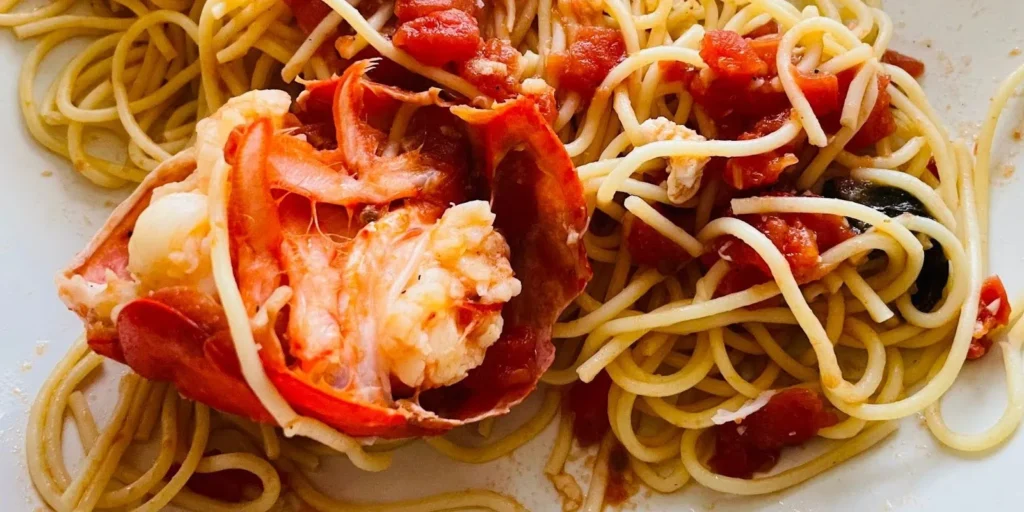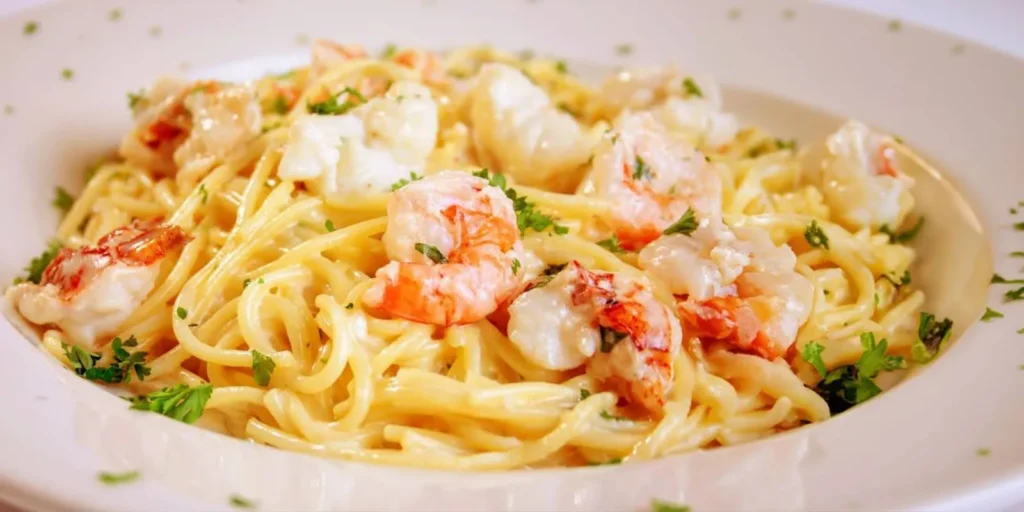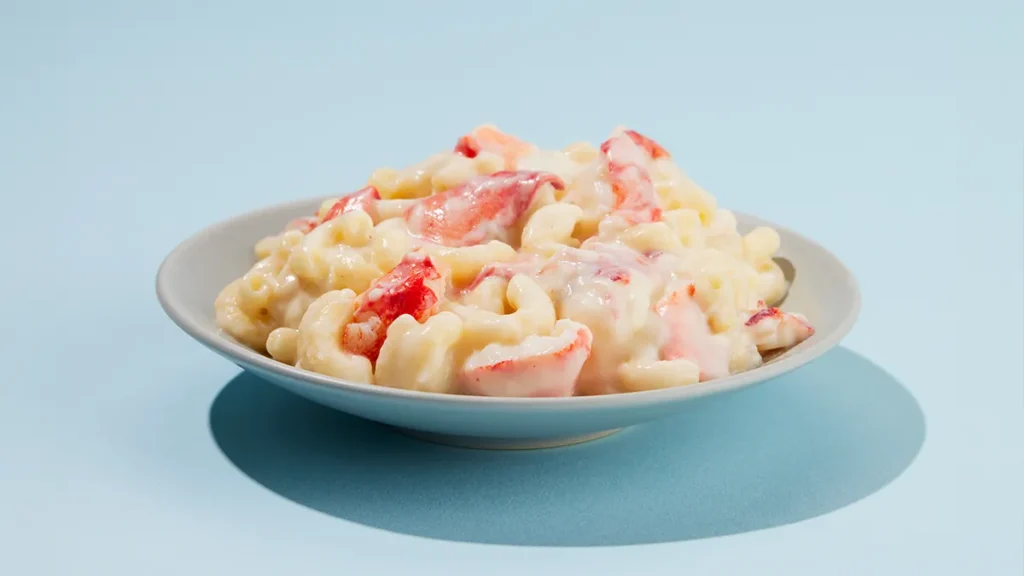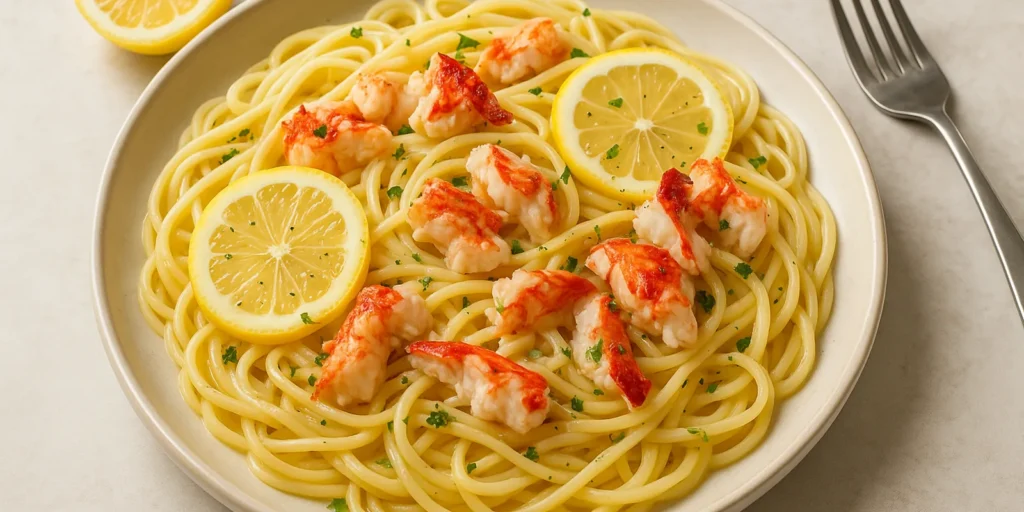
Servings: 3
Ingredients
- 2 lobsters (1.25–1.5 lbs each)
- 5 cups seafood stock or chicken stock (homemade or high-quality store-bought)
- 1/2 stick butter
- 1/4 cup neutral oil (canola or grapeseed preferred)
- 1 cup dry white wine (unoaked Chardonnay works well)
- 1/4 cup brandy, cognac, or dry sherry
- 1 large onion (quartered)
- 1 leek (sliced)
- 1 carrot (sliced)
- 2 celery stalks (sliced)
- 2 tbsp tomato paste
- 1-2 sprigs parsley
- 1-2 sprigs tarragon
- 1/8 tsp cayenne pepper
- Salt and pepper to taste
- 1 cup heavy cream
- 1-2 tsp cornstarch (for thickening, optional)
Instructions
Cook the Lobsters:
- Bring a large pot of water to a low boil.
- Add lobsters and cook for 10–12 minutes, until bright red.
- Remove lobsters and cool. Reserve the cooking water.
- Remove lobster meat and set aside; save shells and any juices.
Sear the Shells:
- In a heavy pot, melt butter with oil.
- Add chopped shells and sauté over medium-high heat until lightly browned.
- Add onion, leek, celery, and carrot. Cook 5–7 minutes until softened.
- Stir in tomato paste and cook 1–2 minutes more.
Deglaze & Simmer:
- Add wine and simmer for 2–3 minutes.
- Add brandy or sherry and let alcohol cook off (another 2 minutes).
- Pour in stock, reserved lobster water, and any juices from the meat.
- Add parsley, tarragon, cayenne, salt, and pepper.
- Simmer uncovered for 1 hour.
Strain & Reduce:
- Strain the broth and press solids to extract every drop.
- Return the liquid to the pot and simmer to reduce by about 1/3.
Blend the Base:
- Place softened vegetables (discard shells) in a blender with cream.
- Blend until silky smooth. Strain if needed.
- Return to reduced broth and whisk to combine.
Thicken & Finish:
- If needed, dissolve cornstarch in a little cold water and stir into bisque.
- Add lobster meat and warm through (do not boil).
- Adjust seasoning and serve hot.
What is Lobster Bisque?
A bisque is a creamy crustacean-based soup, and lobster bisque specifically, is a bisque that originated in France. In France, a bisque is found to be made with almost any crustacean. Crustaceans that are suitable for a bisque can be shrimp, lobster, or even a crayfish. The reason it’s only made from crustaceans is that the broth is derived from boiling the shell to extract the flavor. What makes a soup a bisque is the way the shell of the crustacean is cooked to unlock its flavor. The word bisque refers to cooking something twice, meaning whichever crustacean is used, it’s probably cooked twice.Authentic Lobster Bisque Starts With the Broth
Making lobster bisque is as easy as the cook wants it to be, while still keeping it as close to the original as possible. What makes a lobster bisque a bisque is how the broth is made. The critical step for making true lobster bisque is simmering the lobster shell. Simmering bones, shells, stems, and vegetables are the basis of fine soups around the world. And for a good reason: it yields a delicious broth. A true lobster broth is made from simmering lobster shells together with either a seafood fume/fumet (a seafood broth made from discarded fish bones) or a stock made from chicken.Lobster Bisque is Not an Exact Recipe
There is no one true lobster bisque recipe. There are multiple ways to make it and they’re all considered authentic. The stock used for lobster bisque is one of those forks in the road that confronts every “authentic” recipe. One school of thought says to use fish fumet, while another authentic method recommends chicken stock. Fish fumet is the ideal method for making an authentic lobster bisque, and it’s easy to make. But if you want to skip the fumet then go ahead and use chicken stock instead. Just make sure that the chicken stock is not bursting with strong aromatics and herbs. The chicken stock should be more “chickeny” in flavor and less bold than the canned chicken soup we all grew up eating. Vegetables like celery, onions, leeks, and carrots are ideal, in whatever combination you desire.How to Make Fumet
A fish fumet is made with about a pound of fish bones and/or fish heads, alongside leeks, celery, and onions. Some recipes call for garlic, but garlic calls too much attention to itself, and can crowd out the fish flavor. Instructions: Wash the fish bones and fish heads to remove any blood. If using fish heads it’s okay to cut them into chunks that’ll fit into the pan for sauteing. After washing, boil the fish bones and heads for a few minutes then pour all the water out (this helps to release blood scum from the fish bones). Rinse the bones and heads and set them aside. You’re going to want about five cups of stock, so start with about six cups of water. First, lightly saute the vegetables until they’re soft. Shouldn’t take more than a few minutes. Add the fish bones and/or fish heads. Next, add the six cups of water. Simmer the fish bones together with celery, onions, and leeks for no more than a half hour. Add more water as necessary to keep the simmer on track to produce about five cups of stock. When it’s done, strain out the solids. Then, you have a fumet. The process is the same for making chicken stock from scratch.Take a Shortcut With the Broth
At this point, it’s up to you whether you want to skip the seafood fume and drop in chicken bullion. This step makes the process easy, but it doesn’t diverge from the spirit of the recipe because the result, chicken stock, is the same. The important thing is to keep to the outline of the recipe. Should you take this shortcut, use high-quality bullion such as the ones produced by the Better Than Bullion brand, particularly their low sodium version. Their low-sodium chicken stock tastes like real chicken stock and won’t crowd out the lobster flavor. In my experience, the low sodium Better Than Bullion chicken broth creates an authentic broth that tastes close to made-from-scratch chicken broth. A Word About Cooking Shortcuts The modern cook is accustomed to shortcuts such as using pre-made broths. That’s not surprising because convenience is a hallmark of modern society (and there’s nothing wrong with that). The problem with “easy” recipes is that they take so many shortcuts that the recipe no longer results in an authentic form. Anything made with butter, cream, and salt is going to taste great. But just because a recipe tastes great doesn’t make it authentic. There’s nothing wrong with that, but we’re after authenticity with this recipe.Cooking the Claws and Tails
Use two lobsters for three servings and four lobsters for six servings. The following is for three servings: Boil your lobsters at a low boil (10 to 12 minutes). Save the liquid for later. Using your judgment, pull the lobsters out when they’re bright red. Remove the meat and set it aside in a bowl, and save any lobster meat liquid. Next, chop up the shells and sear them in a mixture of butter and a neutral oil like canola oil. Some recipes call for olive oil, but olive oil has a strong olive flavor. (In my opinion, the olive oil flavor is out of place for a lobster bisque; where the flavors of the lobster and a hint of butter are in the foreground. But that’s just me. Use your judgment, and use olive oil if you wish.) Melt about three-quarters of a stick of butter together with a 1/4 cup of (neutral) oil (or more if necessary) then sear the lobster shells. Next, add one onion chopped in quarters, one leek, one carrot, and two celery ribs, and continue searing for a few minutes until the vegetables soften. Add about two to four tablespoons of tomato paste and mix it all together. Immediately add a cup of white wine, cheap wine is fine (an unoaked chardonnay is a good example). But don’t overthink it because the wine essentially cooks off. The purpose of adding wine is not for the taste of the wine but for bringing out the taste of the food.Add About a Quarter Cup of Brandy, Cognac, or Sherry.
The choice of alcohol you use is yours! Choose between brandy, cognac, or sherry and let that simmer together for a few minutes to burn off the alcohol. Then add the chicken stock or fumet. Next, add about a cup of the lobster cooking water and all of the lobster juices from the lobster meat that was set aside. The chicken stock should cover the lobster shells. If it doesn’t then add some of the leftover lobster juices. Add two to three sprigs each of parsley and tarragon. Simmer everything for an hour. After an hour, strain the lobster broth and squeeze it down to extract as much of the liquid as possible. Pour the liquids into a pot and boil it to cook it down by about a third (this is to concentrate the flavors). Pick out the lobster shells and put the remaining vegetables into a blender, adding a cup of cream to it. Blend it so that there are no more solids, only creamy vegetable lobster cream. If there are any solids, pour them through a strainer to get those solid bits out. Pour the strained creamy liquefied vegetable into the broth. Simmer the bisque and stir to mix everything up.Add Salt and Pepper to Taste
Add 1/8 teaspoon of cayenne pepper powder. It shouldn’t be detectable as pepper hot; its presence should be subtle. Lastly, add the lobster meat once everything is heated through. If the bisque isn’t thick, add half a teaspoon to a teaspoon of cornstarch to thicken it, adding more as needed. Stir the cornstarch around hard with a wooden spoon to crush it down and spread it out. Corn starch tends to clump together, which is what you want to avoid. You can use white flour, but corn starch is easier to work with. How do you know when lobster bisque is thick enough? Simply stick a spoon into the bisque and see if it sticks. Then try and wipe it away from the spoon. If it sticks, it’s done!Classic Lobster Bisque Recipe
There are many ways to make lobster bisque, and there is no such thing as a true lobster bisque recipe. This is just one way among many others to make lobster bisque. Its balance is easy and authentic. Tried this recipe?Let us know how it was!













